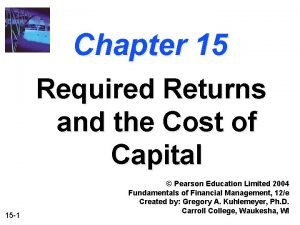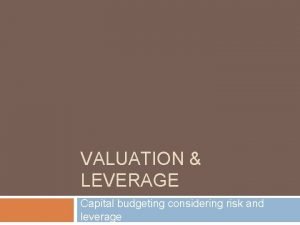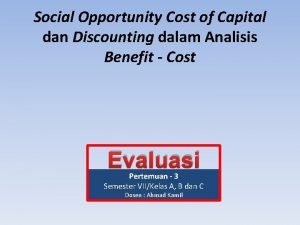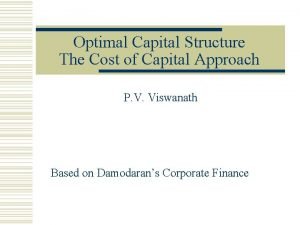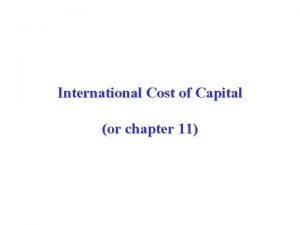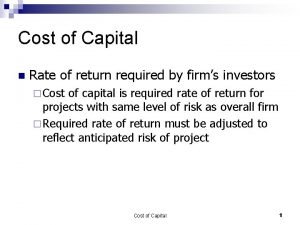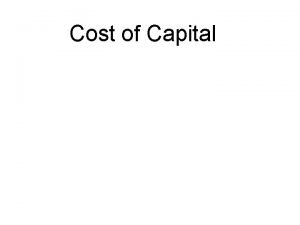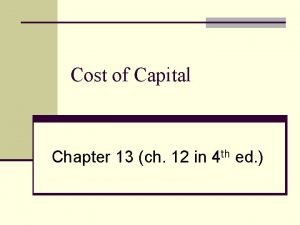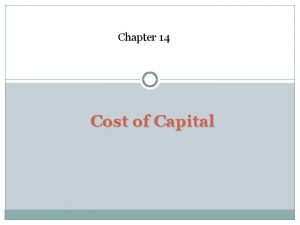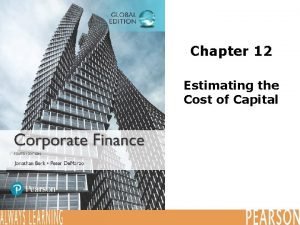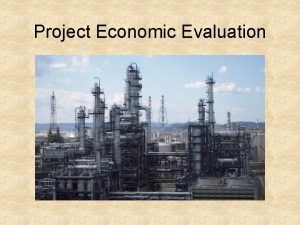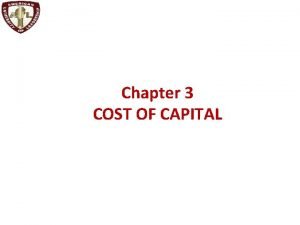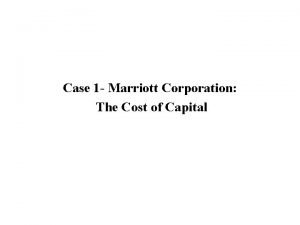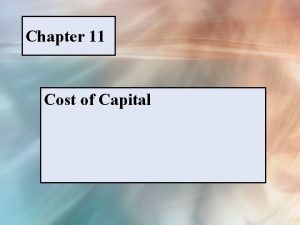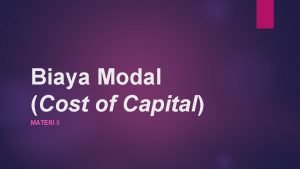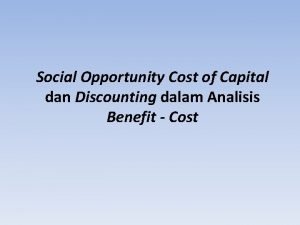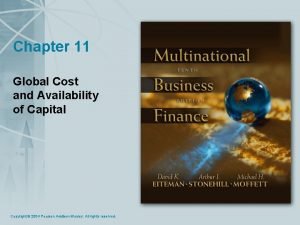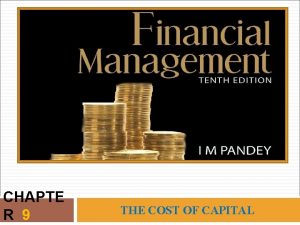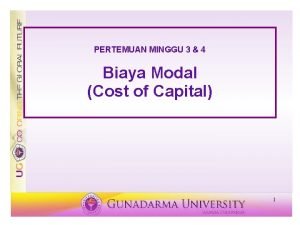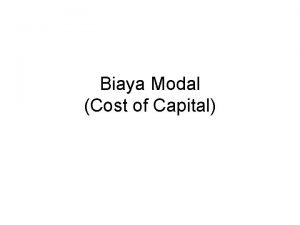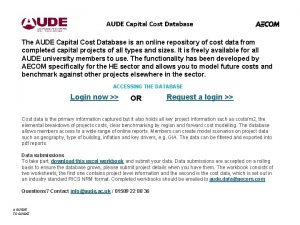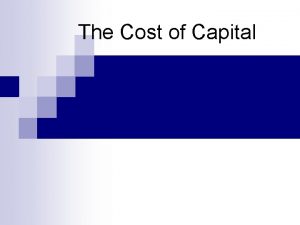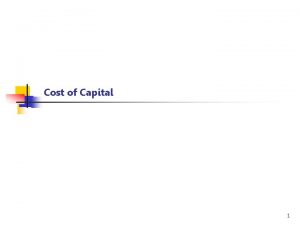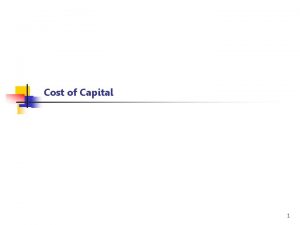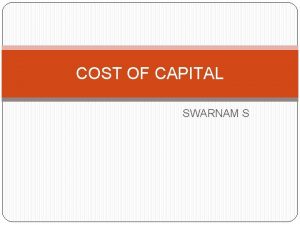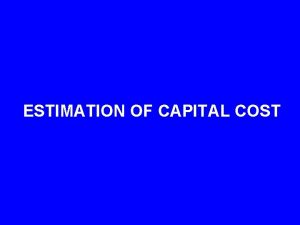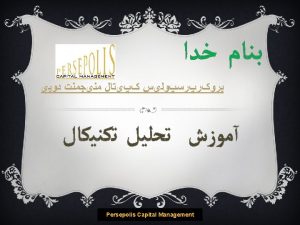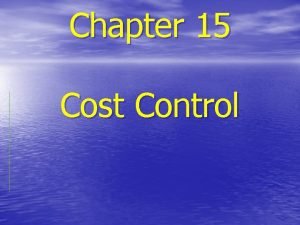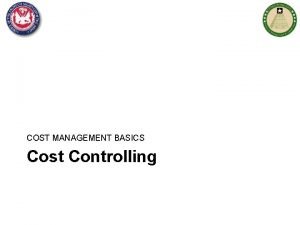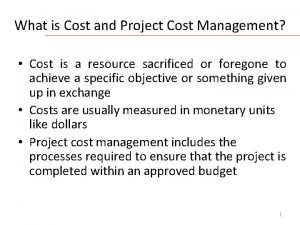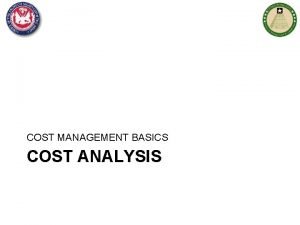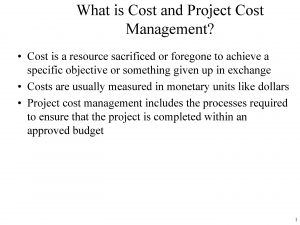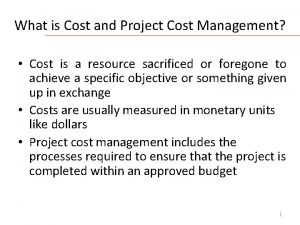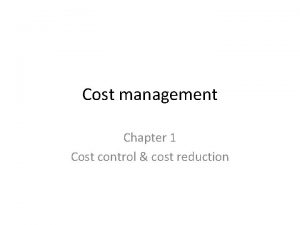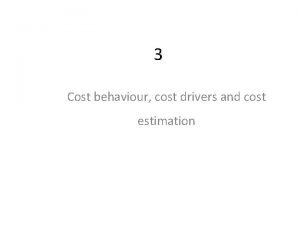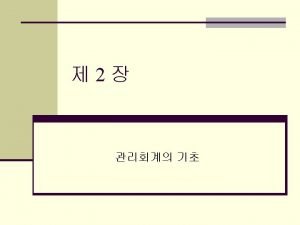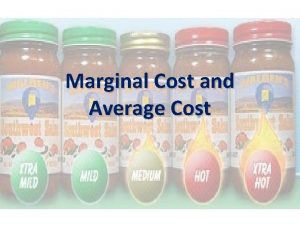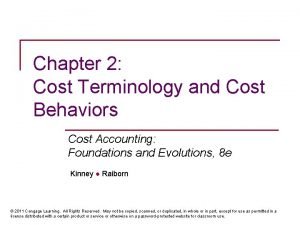Cost of Capital Management Level Paper F 2













































- Slides: 45

Cost of Capital Management Level – Paper F 2 Advanced Financial Reporting Lecture - 004 Vidya Rajawasam ACMA CGMA MBA

Cost of Capital v We have already discussed the subject areas related to Long term finance. v In this lecture we will discuss on Cost of Capital.

Cost of Capital Cost of capital The Cost of Capital refers to the cost of funds used to finance a business. There are two modes of financing § Equity financing § Debt financing

Cost of Capital Cost of capital Many companies use combination of equity and debt financing. Therefore, the need to find out the cost of equity and debt financing or cost of capital has become important.

Cost of Capital Cost of capital The overall cost of equity and debt financing is calculated through the Weighted Average Cost of Capital. Which is known as WACC used as a discount rate in Net Present Value calculations.

Cost of Capital Cost of capital The WACC is derived by estimating cost of each source of finance separately. i. e. Cost of ordinary shares, preference shares, debt etc. . Then calculating the weighted average value of individual costs.

Cost of Capital Cost of capital The formula for WACC calculation is. . VE ko = k e VD _______ + kd VE + VD _______ VE + VD

Cost of Capital The Cost of Equity - ke The rate of return expected by the ordinary shareholders on their investment. The main method of calculating the Cost of Equity is called the Dividend Valuation Model (DVM)

Cost of Capital The Dividend Valuation Model (DVM) This method determines the current share price of the shares based on the future dividends, discounted at the rate of return required by the investors. There are two DVM models.

Cost of Capital The Dividend Valuation Model (DVM) With constant dividend d P 0 = ______ ke P 0 = the ‘ex div’ market price of the share d = Constant dividend , ke = Cost of Capital

Cost of Capital The Dividend Valuation Model (DVM) Therefore, ke calculation with constant dividend d ke = ______ P 0 = the ‘ex div’ market price of the share d = Constant dividend , ke = Cost of Capital

Cost of Capital The Dividend Valuation Model (DVM) Exam focus, The Ex dividend or ‘ex div’ value of the share price means, value of the share price just after dividend is paid. The share price just before the dividend is paid is known as ‘cum div’ price.

Cost of Capital The Dividend Valuation Model (DVM) Exam focus, If the ‘cum div’ price is indicated in the question, we need to find the ‘ex div’ price by deducting the dividend to be paid for a share.

Cost of Capital The Dividend Valuation Model (DVM) Exam focus, Example – A 20 cents dividend to be paid for a share which has a ‘cum div’ value of $ 3. 45, what is the ‘ex div’ price that can be entered into the DVM formula? Answer - $3. 45 - $ 0. 20 = $ 3. 25

Cost of Capital The Dividend Valuation Model (DVM) Example Smith plc’s shares are quoted at $12 per share. A dividend payment of $0. 75 per about to be paid. There is no growth in dividends. Calculate the cost of equity ?

Cost of Capital Example, Application of formula, d ke = ______ P 0 = the ‘ex div’ market price of the share d = Constant dividend , ke = Cost of Capital

Cost of Capital Example, Application of formula, . 75 ke = ______ 12 -. 75 ke = 6. 70%

Cost of Capital The Dividend Valuation Model (DVM) With constant dividend growth d 0 ( 1 + g ) P 0 = _____ +g ke P 0 = the ‘ex div’ market price of the share. d 0 = current dividend, g= rate of growth.

Cost of Capital The Dividend Valuation Model (DVM) ke calculation with constant dividend growth d 0 ( 1 + g ) ke = _____ +g P 0 = the ‘ex div’ market price of the share. d 0 = current dividend , g= rate of growth.

Cost of Capital The Dividend Valuation Model (DVM) Example Jaden plc’s shares are quoted at $4 per share. A dividend payment of $0. 30 per about to be paid. The expected growth rate of dividend is 5%. Calculate the cost of equity ?

Cost of Capital The Dividend Valuation Model (DVM) Example , Application of formula. . d 0 ( 1 + g ) ke = _____ +g P 0 = the ‘ex div’ market price of the share. d 0 = current dividend, g= rate of growth.

Cost of Capital The Dividend Valuation Model (DVM) Example , Application of formula. . 30 x 1. 05 ke = _____+0. 05 400 - 30 ke = 13. 5%

Cost of Capital Review MCQs The ordinary shares of ABX plc a UK listed company are quoted at $4 share. Ad dividend of $0. 30 is about to be paid by the company. There is no growth in dividends. Calculate the cost of equity? a) b) c) d) 8. 68% 8. 00% 8. 26% 8. 10%

Cost of Capital Review MCQs Application of formula, d ke = ______ P 0

Cost of Capital Review MCQs Application of formula, 30 ke = ______ 400 - 30 ke = 8. 10%

Cost of Capital Review MCQs The ordinary shares of ABX plc a UK listed company are quoted at $4 share. Ad dividend of $0. 30 is about to be paid by the company. There is no growth in dividends. Calculate the cost of equity? a) b) c) d) 8. 68% 8. 00% 8. 26% 8. 10%

Cost of Capital Review MCQs ABX plc’s ordinary shares are quoted at $12 per share. Ad dividend of $0. 75 per share is about to be paid. The expected growth rate in dividend is 8%. Calculate the cost of equity? a) b) c) d) 15. 68% 15. 00% 15. 20% 14. 99%

Cost of Capital Review MCQs Application of formula. . d 0 ( 1 + g ) ke = _____ +g P 0 = the ‘ex div’ market price of the share. d 0 = current dividend, g= rate of growth.

Cost of Capital Review MCQs Application of formula. . 75 x 1. 08 ke = _____+0. 08 1200 - 75 ke = 15. 2%

Cost of Capital Review MCQs ABX plc’s ordinary shares are quoted at $12 per share. Ad dividend of $0. 75 per share is about to be paid. The expected growth rate in dividend is 8%. Calculate the cost of equity? a) b) c) d) 15. 68% 15. 00% 15. 20% 14. 99%

Cost of Capital The Cost of Preference Shares - kp The preference shares usually pay a constant level of dividend. The value of the dividend is quoted as a percentage of nominal value of preference shares.

Cost of Capital The Cost of Preference Shares - kp The cost of preference shares can be calculated by the following formula. d kp = _____ P 0 d = constant dividend , P 0 = Ex div Market price, kp = cost of preference shares

Cost of Capital The Cost of Debt - kd The rate of return expected by the debt providers on the funds provided. The value of the debt is assumed to be the present value of its future cash flows.

Cost of Capital The Cost of Debt - kd The features are; – The debt is tax deductable, i. e. the interest payments are made net of tax. – The debt is always quoted in $100 nominal blocks or units.

Cost of Capital The Cost of Debt - kd The features are; – The interest payments are stated as a percentage of nominal value. – The interest rate is known as Coupon rate.

Cost of Capital The Cost of Debt - kd The features are; – The amount of interest payable on debt is fixed. – The interest is calculated by the Coupon rate multiplied by the nominal value of the debt.

Cost of Capital The Cost of Debt - kd The features are; – The is generally redeemable at par (Nominal Value) or at a premium or at a discount. – The interest amount can be fixed or floating (Variable) on borrowings.

Cost of Capital The Cost of Debt - kd The features are; – With related to bonds, the interest rates remain fixed.

Cost of Capital The Cost of Debt (kd) – for Bank borrowings. The calculation is kd = r (1 -T) Where, r = annual interest rate T = Corporate tax rate.

Cost of Capital Review MCQs What statement is true with regard to cost of preference shares ? a) Preference shares does not pay any dividends. b) Preference shares not traded in stock markets. c) Preference shares usually pay a constant level of dividend.

Cost of Capital Review MCQs What statement is true with regard to cost of preference shares ? a) Preference shares does not pay any dividends. b) Preference shares not traded in stock markets. c) Preference shares usually pay a constant level of dividend.

Cost of Capital Review MCQs What statement is true with regard to features of Debt? a) Debt is not tax deductible b) Debt is always redeemable at par. c) The amount of the interest payable on debt is fixed. d) Bonds generally pay floating interest rates.

Cost of Capital Review MCQs What statement is true with regard to features of Debt? a) Debt is not tax deductible b) Debt is always redeemable at par. c) The amount of the interest payable on debt is fixed. d) Bonds generally pay floating interest rates.

Cost of Capital Lecture Summary - WACC - Cost of equity - Dividend Valuation Models - Cost of preference shares - Cost of Debt

Cost of Capital Management Level – Paper F 2 Advanced Financial Reporting Lecture - 004 Vidya Rajawasam ACMA CGMA MBA
 Multinational cost of capital and capital structure
Multinational cost of capital and capital structure Multinational cost of capital and capital structure
Multinational cost of capital and capital structure Cost of capital in financial management
Cost of capital in financial management Fixed capital and working capital
Fixed capital and working capital Difference between capital reserve and reserve capital
Difference between capital reserve and reserve capital Difference between capital reserve and reserve capital
Difference between capital reserve and reserve capital Basle ii
Basle ii Regulatory capital vs economic capital
Regulatory capital vs economic capital Constant capital and variable capital
Constant capital and variable capital Capital allocation line vs capital market line
Capital allocation line vs capital market line Paper 2 aice general paper
Paper 2 aice general paper Aice general paper 1 example essay
Aice general paper 1 example essay Basic principles of cost management in project management
Basic principles of cost management in project management Adjusted present value
Adjusted present value Marginal cost of capital
Marginal cost of capital Social opportunity cost adalah
Social opportunity cost adalah Optimal capital structure
Optimal capital structure International cost of capital
International cost of capital International capital budgeting techniques
International capital budgeting techniques Cost of capital required rate of return
Cost of capital required rate of return Equity shares example
Equity shares example Marginal cost of capital
Marginal cost of capital Chapter 14 cost of capital
Chapter 14 cost of capital How to find unlevered cost of equity
How to find unlevered cost of equity Cost estimation
Cost estimation Cost efficient capital market
Cost efficient capital market Objectives of cost of capital
Objectives of cost of capital Marriott corporation the cost of capital solution
Marriott corporation the cost of capital solution Cost of capital ppt
Cost of capital ppt Marginal cost of capital adalah
Marginal cost of capital adalah Social opportunity cost of capital adalah
Social opportunity cost of capital adalah Availability of capital
Availability of capital Book value of debt
Book value of debt Cost of capital adalah
Cost of capital adalah Materi biaya modal
Materi biaya modal Pengertian cost of capital
Pengertian cost of capital Cost accumulation and cost assignment
Cost accumulation and cost assignment Cost accumulation and cost assignment
Cost accumulation and cost assignment Manufacturing cost vs non manufacturing cost
Manufacturing cost vs non manufacturing cost Process costing vs job costing
Process costing vs job costing Floatation cost
Floatation cost Cost concept and classification
Cost concept and classification Cost pools
Cost pools Manufacturing cost vs non manufacturing cost
Manufacturing cost vs non manufacturing cost What is standard costing and variance analysis
What is standard costing and variance analysis Cost accumulation and cost assignment
Cost accumulation and cost assignment


